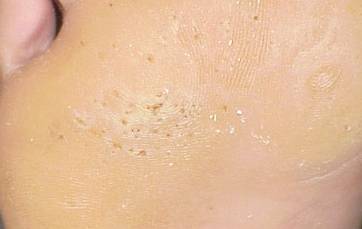Pitted Keratolysis: symptoms, prevention and treatment - Dr Yeung Ho Hong 楊浩康

Symptoms of Pitted Keratolysis
Pitted Keratolysis is a skin condition caused by bacterial infection, primarily affecting the superficial layers of the soles of the feet. It is characterized by abnormal white patches on the skin, accompanied by clusters of small pits, giving the appearance of the sole being perforated. While this condition is not life-threatening, it can cause significant discomfort and may lead to the distressing issue of foot odor, especially when wearing enclosed shoes for extended periods.
The primary cause of pitted keratolysis is the infection of the skin by specific types of bacteria, including corynebacteria, Dermatophilus congolensis, Kytococcus sedentarius, actinomyces, and streptomyces. These bacteria thrive in moist environments and secrete proteases that break down the skin’s keratin layer, forming tiny pits. Additionally, the metabolites of these bacteria contain sulfur compounds, which release an unpleasant odor, contributing to foot odor and further impacting the patient’s social and psychological well-being.
The triggers of pitted keratolysis involve a combination of environmental and physical factors. Hot and humid weather, prolonged wearing of non-breathable footwear, and thickened skin on the palms or soles can keep the feet in a persistently moist state, creating an ideal environment for bacterial growth. Furthermore, individuals with hyperhidrosis (手腳多汗症), who experience excessive sweating and continuously moist skin, are at higher risk. People with diabetes or compromised immunity are also more susceptible to these bacterial infections due to impaired skin barrier function, increasing the likelihood of developing the condition.
The symptoms of pitted keratolysis are primarily concentrated on the soles of the feet. Patients may exhibit white patches on the skin, accompanied by multiple small pits, and sometimes mild redness or irritation. Although these pits are typically painless, prolonged walking or standing may cause itching, slight pain, or discomfort. In more severe cases, the number of pits may significantly increase, and secondary infections could worsen local swelling and odor issues.
Diagnosing pitted keratolysis typically relies on a clinical examination by a dermatologist. The doctor will determine the cause by taking a detailed medical history and closely observing the characteristics of the skin on the soles. In some cases, skin scrapings or culture techniques may be used to identify the specific bacteria responsible for the infection. For atypical or difficult-to-diagnose cases, dermoscopy can also effectively differentiate the condition.
Treatment for pitted keratolysis primarily focuses on topical medications, supplemented by proper foot hygiene management. Antibiotic ointments such as erythromycin (‘紅黴素’), clindamycin (‘克林黴素’), or fusidic acid (‘夫西地酸’) are common treatment options, as they directly inhibit bacterial activity and help eliminate the infection source. For patients with mild cases, applying the ointment moderately each day typically leads to significant symptom improvement within a few weeks. Keeping the feet dry is crucial, and the use of moisture-absorbing insoles or treatments for hyperhidrosis can reduce skin moisture and prevent recurrence.
For severe or recurrent cases, doctors may recommend a comprehensive treatment approach. This could involve combining antibacterial agents, keratolytic agents, and specialized foot care creams to repair the skin barrier and reduce infection risk. Additionally, proper foot cleaning and protective measures—such as using antibacterial foot powder, wearing breathable shoes and socks, and regularly airing out footwear—can effectively lower bacterial proliferation rates.
The most important strategy for preventing pitted keratolysis is maintaining clean and dry feet. Choosing breathable shoes and moisture-wicking socks, while avoiding tight or non-breathable footwear, forms the foundation for preventing bacterial growth. Routine foot care, such as washing with warm water and thoroughly drying the feet, can also effectively reduce the risk of bacterial infection. Regularly using antibacterial foot powder and keeping the shoe environment well-ventilated can further minimize bacterial growth.
In summary, pitted keratolysis is a bacterial infection affecting the skin of the soles, and while it is generally benign, untreated cases may lead to severe foot odor and localized infections. With accurate diagnosis and targeted treatment, most patients can successfully alleviate symptoms and improve foot health. At the same time, cultivating good foot hygiene habits is key to preventing the condition.
